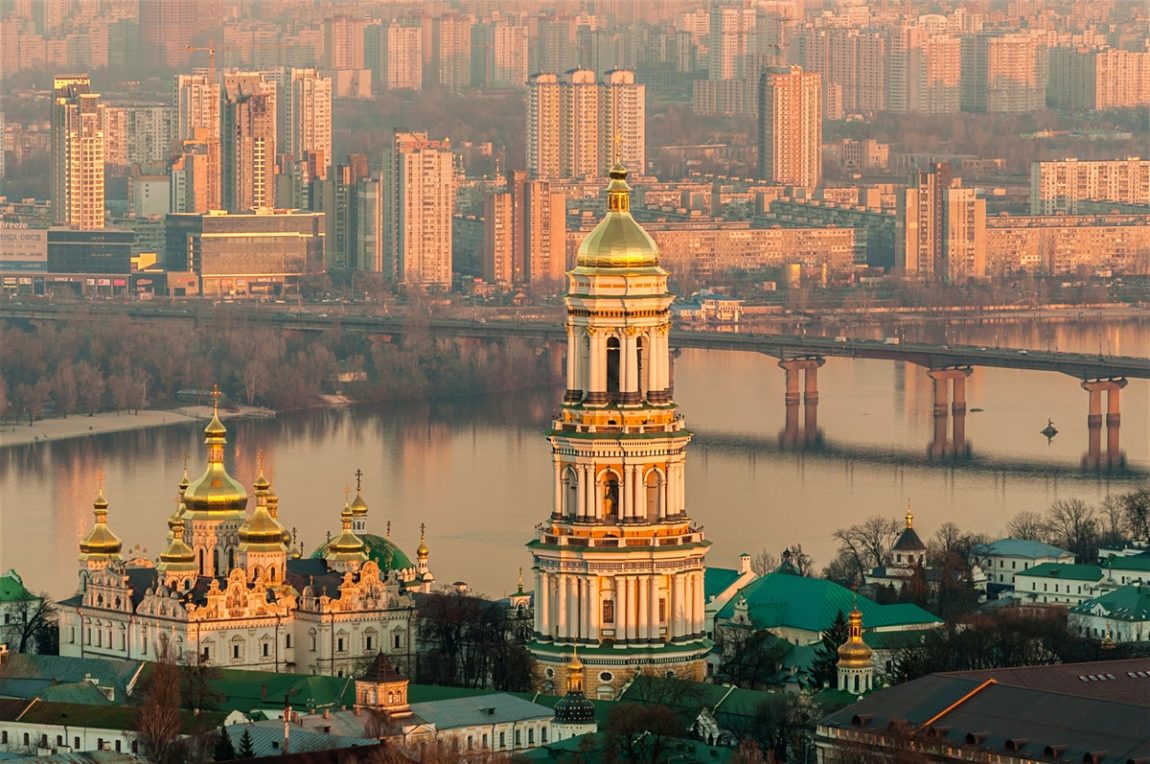If you’re wondering if Kiev is worth visiting there’s a simple answer to that question – definitely yes! There are so many reasons to visit Kiev, from amazing architecture to interesting history and vibrant atmosphere and each of them is already a good excuse to plan the trip to the capital of Ukraine.
The architecture of Kiev, as well as all of Ukraine, has always been famous for its original and skillfully constructed buildings. The city of Kiev was built more than 1500 years ago. Those days, same as today, the city was famous for its masters, who could construct buildings of indescribable beauty.
Kiev Best Attractions
St. Andrew’s Church

As exquisite diamond crowns the work of art of the jeweler, so the St. Andrew’s Church crowns the famous historical Andreevsky Descent. The work of the great Bartolomeo Rastrelli was designed by the order of Empress Elizabeth in 1748 and performed in elegant baroque style. The St. Andrew’s Church is located on Starokievska Mountain, where in ancient times the pagan idol of Perun stood; standing on this mountain Apostle Andrew the Protocletos foretold the great future of the city built here.
Legend
One of the earliest Kiev legends is connected with St. Andrew’s Church. It says that the twelve apostles of Christ dispersed around the world, carrying the light of faith. Saint Andrew had to go to Proponthys, Thrace, Hellas and Scythian lands. Moving from Sinop through Korsun, Andrew went to the mouth of the Dnieper River to continue his journey along the river to the Black Sea and from there to Rome. Having stopped for the night at one of the picturesque Dnieper hills, and in the morning, having woken up with his disciples on one of the hills, the Apostle told them: “Do you see these mountains? On the mountains, the grace of God will shine and there will be a big city here, and God will build many churches on this place.”
History
In 1744 Russian Empress Elizaveta Petrovna issued a decree on the construction of a stone church on the Andreevsky Descent. During her visit to Kiev, Elizaveta with her own hands laid the symbolic first three bricks in the foundation of the church, and the place was consecrated by Metropolitan of Kiev Rafail Zaborovsky. Kiev treasury was ordered to allocate about twenty thousand rubles for the construction, and by a special decree it was authorized to cut the forest free of charge throughout Malorossia and to hire workers for a minimal fee. It was Johann Gottfried Schädel who was first supposed to design the temple; however, his project was rejected by the Petersburg Chancellery, and the project was given to Francesco Bartolomeo Rastrelli, the Chief Architect of the Imperial Court.
To know more about this sight, book private tour with a local around Podil – Podil Tour.
St.Sophia Cathedral

St. Sophia Cathedral in Kiev was built in the XI century. The exact date of its foundation is still disputed by historians. Therefore, so far, some historians have argued that the Kiev Sophia was constructed on the order of Yaroslav the Wise, and others – on the order of St. Vladimir.
Until now, the Cathedral stored the world-known mosaic “Our Lady Oranta”. However, 200 years after its foundation, after raids of enemy troops, the cathedral was destroyed. Later St. Sophia Cathedral was restored, and the renovation of the temple was carried out until 1740. Since 1934, St. Sophia Cathedral and buildings that are located next to it have formed a historical architectural reserve “The St. Sophia Cathedral Museum”. It is part of the UNESCO world heritage.
Architecture of the Cathedral
The Cathedral has a special place in the architecture of Kiev. The structure of the St. Sophia Cathedral can be represented in the form of a cross-domed church with five towers and 13 cupolas. The composition of the Cathedral was pyramidal. Surrounded by four small domes, there was the largest central dome. At the same time, the smallest domes were in the corners of the Cathedral.
Today, after a number of restorations, the Sophia Cathedral has changed a lot. The shape of its cupolas was changed to a pear-shaped one; the superstructure of the external galleries was performed. However, the original elements of the architecture of Kiev can be seen from the altar.
To get inside the temple to admire its beauty take a private guide who will tell you about each piece of this shrine – Old Town Tour.
Golden Gate

Thousands of people from Kiev and visitors of the city bypass the Golden Gate every day, as an obstacle in their programmed way “to work – from work.” And few of them think about why this decorative structure stands here; few of them even know that four decades ago in place of this building there were ruins that are now hidden under the new setting. And those ruins are the most ancient fortification structure in Ukraine, the only one that combines the features of the defense and religious architecture of Kievan Rus.
Prince Yaroslav built Golden Gate in Kiev by the example of the Golden Gate of Constantinople; however, they are not similar in architecture.
In 1240, Kiev was destroyed by the troops of the Mongol-Tatar Khan Batu. The Tatars attacked the Lyadsky Gate, because it was considered the most vulnerable among the Kiev gates. Bloody battles took place under the Golden Gate too.
During the National Liberation War in 1648 the Golden Gate became the place of a triumphal meeting of the Cossack army of Bogdan Khmelnitsky. Although by that time they were already very destroyed. This is confirmed by the unique drawings of the Dutch artist Abraham van Westerfeld.
Now in the pavilion, which reproduces the original appearance of the Golden Gate, a museum is built.
Kiev-Pechersk Lavra

Kiev-Pechersk Lavra is perhaps one of the most famous and popular sights of Kiev. The residents of the capital, its guests, pilgrims and believers, as well as ordinary tourists – everybody comes here to see it. It attracts men, women, old people and children. This place is interesting as it has the most ancient history, interesting artifacts, beauty of churches and miraculous icons, mysterious caves and amazing legends.
The history of the Kiev-Pechersk Lavra begins in 1051, at the time of Prince Yaroslav the Wise. Seeking solitude, the monks organized a cave city here. The first cave was settled here by Hilarion, who later became Metropolitan of Kiev. After him Antony settled here, who became the founder of the Pechersky Monastery. He and Theodosius contributed to the creation of the most famous shrine.
History of the shrine
In 1073 Antony built here the Cathedral of the Assumption of the Blessed Virgin. The very word “lavra” from Greek denotes a built-up block or church parish.
The monastery was repeatedly attacked, destroyed and burned. In 1096, Polovtsy attacked the city, which also affected the shrine. In 1151 the Turks came here, in 1169 – the Berendeys. In 1240 the city was attacked by Batu. And in 1718 there was a fire in the Lavra.
In the 11th century, the Kiev-Pechersk Lavra, being a large feudal lord had three cities, 7 small towns, about 200 villages and hamlets, 70,000 peasants, factories, taverns, distilleries and mills, deserts submitted. In addition, the Lavra was the center of the book-writing. One of the most famous books is the Kiev Pechersk Paterikon.
In Soviet times, namely, since 1917, the Lavra was again destroyed. Those days USSR sought to exterminate the clergy, and this Kiev shrine was attacked as well.
In 1941, the Assumption Cathedral in Kiev was undermined. Even today it is a contentious issue who did this. There is an opinion that it was the Soviet side, but there is another point of view. This could be done by the Germans under the leadership of Eric Koch. The Cathedral was restored only in 1995 by the decree of President Leonid Kuchma.
In 1988 spiritual life returned to the Lavra. In 1990, it became UNESCO World Heritage site. In 1999, the Seminary opened here – now it is called the Kiev Theological Academy and Seminary.
The Kiev-Pechersk Lavra is a complex of various structures. In addition to the already mentioned Uspensky Cathedral, there is also a bell tower in the Middle Caves, a bell tower on the Far Caves, the Onufrievskaya Tower, the Refectory Church of Saints Anthony and Theodosius, the Cross Exaltation Church, the Church of the Nativity of the Blessed Virgin, the Church of the Icon of Our Lady, the Church of All Saints, the Trinity Gate Church, Church of the Savior on Berestov, the Church “The Life-giving Spring”, the Church and former hospital rooms of the St. Nicholas Monastery, the Annozachatievska Church, galleries, former cells and much more.
To know more about the Monastery, book private Kiev Pechersk Lavra Tour.
The Motherland Monument

One of the largest memorial complexes on the territory of the former Soviet Union is located on the outskirts of the Pechersk district of Kiev.
Do not even try to get around and see everything in one visit. The complex covers the territory of more than 10 hectares and has about 400 thousand exhibits, silent witnesses of many wars, from the Great Patriotic War to the Afghan War. The museum was opened in 1974. After that it moved several times until May 9, 1981, when it was given its current residence. In 1996 the museum received the status of the national. The 102-meter Motherland Monument weighing 530 tons rises above the building of the museum.
The museum itself has 5 floors, each dedicated to a specific topic. Among them there is the Hall of Battle Glory, in its center you will see the Order of Victory with a diameter of five meters. Even a list of alleys, monuments, galleries and exhibits of the memorial complex would be endless. One just has to go there and see it. Even the first visit to the museum will give you a lot in understanding the greatness of the feat accomplished by our great-grandfathers, who managed to protect their land from the fierce enemy.
Pirogovo

Museum of Folk Architecture and Life “Pirogovo” was established in 1976 on the outskirts of Kiev in a beautiful relief village called Pirogovo. This amazing architectural and landscape complex has an area of more than 150 hectares and perfectly reflects the way of life, architecture and natural features of different regions of our country. The territory of the museum is divided into sectors according to belonging to time and territory.
Here you can see about 300 structures made of wood from 17-20 centuries, which are brought from different parts of Ukraine. There are valuable architectural exhibits from Poltava and Dnieper regions, Carpathians, southern Ukraine, Polissya and Slobozhanshchina. You will see farm buildings, residential and religious buildings. The unique open-air exposition of Pirogovo shows peculiarities of the architecture of Ukrainian village, folk art of our ancestors, unique and colorful life of peasants.
The most popular exhibits
The oldest sight of the museum is the hut (1-room) with a stove built in 1587. In addition, the most important and central exhibit is a group of windmills, which miraculously fit into the picturesque landscape of the museum territory and are located on a high hill. Cozy wooden churches are a valuable addition to the local panorama. The oldest of these is the Nadnepryanska Church, built in 1742.
Why it is interesting
Museum of Folk Architecture and Life “Pirogovo” in Kiev allows you to move into the past, enjoying unique ancient landscapes, remarkably supplemented with hay barns, 16th and 17th century churches and windmills. All these exhibits are truly unique and of great value from a historical and architectural point of view. The objects were brought from different cities of Ukraine and subjected to detailed restoration works with the use of corresponding historical materials.
Contact a local in Kiev that I used and highly recommend to explore Kiev sights together:
- +380 66 067 90 89 WhatsApp, Viber, SMS, Calls
- info@guideme.com.ua
- Skype: Guide me UA
- www.guideme.com.ua




